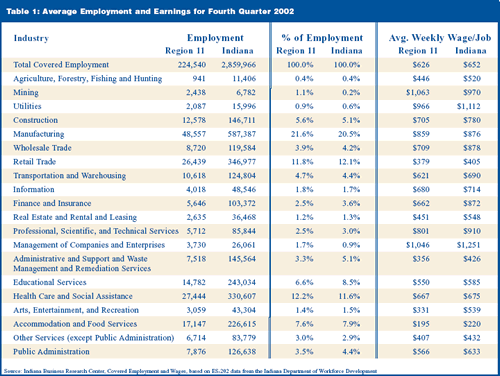Commerce Region 11: Southwest Indiana
The Area
Commerce Region 11 is comprised of 11 counties in southwest Indiana: Daviess, Dubois, Gibson, Knox, Martin, Perry, Pike, Posey, Spencer, Vanderburgh and Warrick. The six-county Evansville metropolitan statistical area (metro) includes four Indiana counties, along with Henderson and Webster counties in Kentucky. Vincennes, Jasper and Washington are primary cities of micropolitan statistical areas (micros), the new statistical entity developed by the Office of Management and Budget in June.
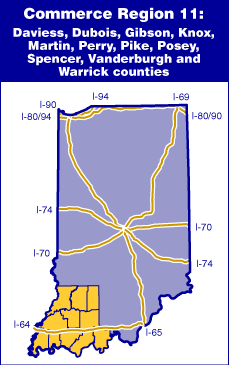
Vanderburgh County is the population center of the area—and the seventh largest county in the state—with 37.8 percent of the region's 455,112 residents, according to Census 2000 (see Figure 1). Martin and Pike counties are mostly rural areas, each accounting for less than 3 percent of the regional population.
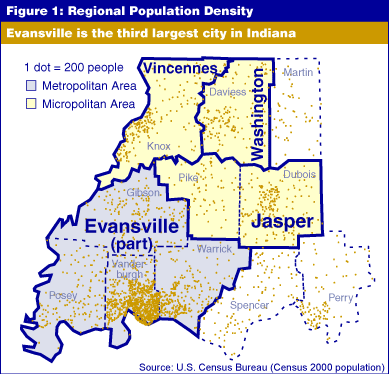
Region 11 was one of the slowest-growing Indiana regions in the past decade, with a 5 percent change in population—roughly half of the state's rate. Between 1990 and 2000, the Evansville metro grew slightly faster than the region at 6 percent. Of the counties in Region 11, Warrick County grew fastest, both numerically (7,463) and on a percentage basis (16.6 percent). The strong growth in this suburban area of Evansville accounted for almost half of the metro's growth among the Indiana counties.
Suburbanization has continued to impact the city of Evansville, which remains the third largest city in Indiana. Evansville lost 3.7 percent of its population during the 1990s and this decline accelerated, with the city losing an additional 2.1 percent in the two years from April 2000 to July 2002.
Industrial Mix and Jobs
Major employers in the area include Alcoa, American General Finance, Berry Plastics, Bristol-Myers Squibb, Naval Surface Warfare Center Crane Division (NSWC Crane), Deaconess Hospital, GE Plastics, Good Samaritan Hospital, Jasper Engines and Transmissions, Kimball International, MasterBrand Cabinets, Mead Johnson Nutritionals, Perdue Inc., St. Mary's Medical Center, TJ Maxx Distribution Center, Toyota Motor Manufacturing and Whirlpool.
Overall, Region 11's industrial mix mirrors the state as a whole. In 2000, the services sector comprised 26.4 percent of regional employment, followed by 18.8 percent in manufacturing. Between 1990 and 2000, nonfarm employment grew 17.5 percent, with the greatest numeric growth in services (14,987 new jobs) and the largest percent change in finance, insurance and real estate (40.1 percent). In an era of plant closings, manufacturing had a healthy 10.8 percent growth during the decade, adding over 5,000 jobs. In fact, within the past year, the Toyota plant in Princeton (Gibson County) expanded employment by 80 percent, bringing its number of employees to approximately 4,700.
Significant job losses occurred in the military and federal civilian sectors, with declines of 26.8 percent and 18.2 percent, respectively, and a combined loss of 1,888 jobs. This is mostly attributable to NSWC Crane in Martin County, which remains the third largest Navy base in the world and the largest employer of engineers and scientists in the state. According to a report released by the Southern Indiana Business Alliance in August 2003, annual revenue from the base is $1 billion.
While the Martin County base draws workers from 31 Indiana counties, about 2,250 Crane employees live in Martin and Daviess counties, earning $68.5 million in wages. As the federal government begins making downsizing decisions in accordance with the 2005 Base Realignment and Closure Act (which is estimated to cut military operations up to 25 percent), Region 11 will have to wait and see how well Crane survives the cuts.
Region 11 has been operating at high levels of employment for the past several years. For July 2003, the unemployment rate was 4.0, ranking it lowest among the 12 Commerce regions. As seen in Figure 2, the unemployment rate for Region 11 has been lower than the state average each month since December 2000 (data is not seasonally adjusted).
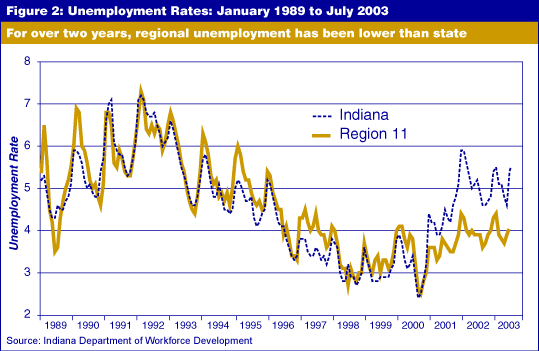
Commuting Patterns
As can be expected with 171,744 residents, Vanderburgh is the employment hub of Region 11, employing 118,694 area workers in 2002. Over 23,000 people commuted from the other 10 counties, while 95,081 lived and worked in Vanderburgh (see Figure 3).
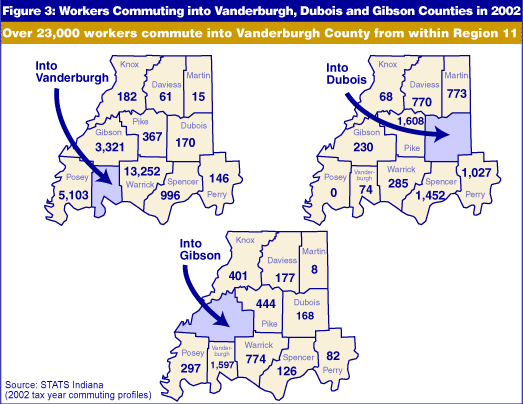
After Vanderburgh, businesses in Dubois and Gibson counties employed the most commuters from within Region 11 (6,287 and 4,074, respectively). Meanwhile, Martin, Knox, Pike and Perry counties each drew less than 1,000 commuters from within the region.
Income and Wages
Workers in southwest Indiana are among the highest compensated in the state with per capita personal income (PCPI) for 2001 at $27,860, exceeding the state average by $338. This ranked Region 11 second among the Commerce regions, falling behind only Region 7 (the nine-county Indianapolis area), where PCPI was $31,960.
However, when looking at the 2002 fourth quarter data in Table 1, the average weekly wage in Region 11 was slightly lower than in the state overall. Among the various industry sectors, only mining wages were higher for Region 11 than the state. The biggest differential was in finance and insurance, where employees in southwest Indiana earned $210 less per week than their Hoosier counterparts in other areas of the state.
Additional data is available at: www.stats.indiana.edu/profiles/prcomm11.html.
Rachel Justis
IN Context Managing Editor, Indiana Business Research Center,
Kelley School of Business, Indiana University

